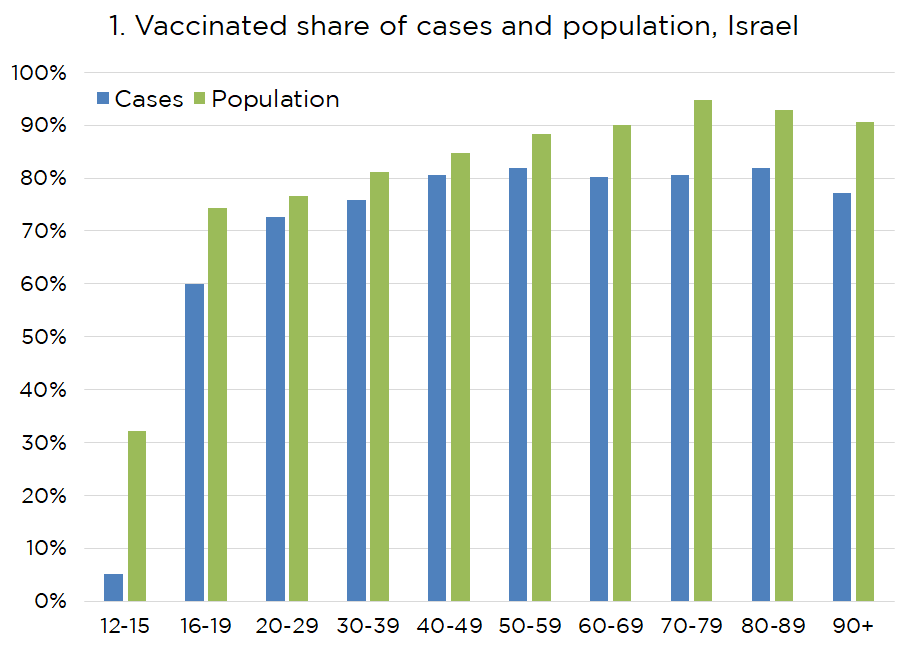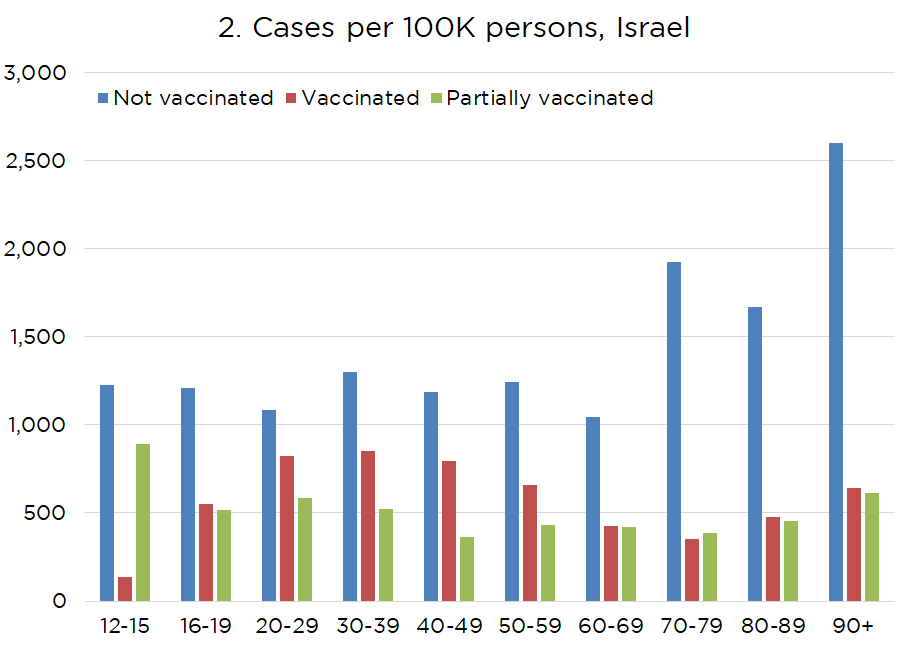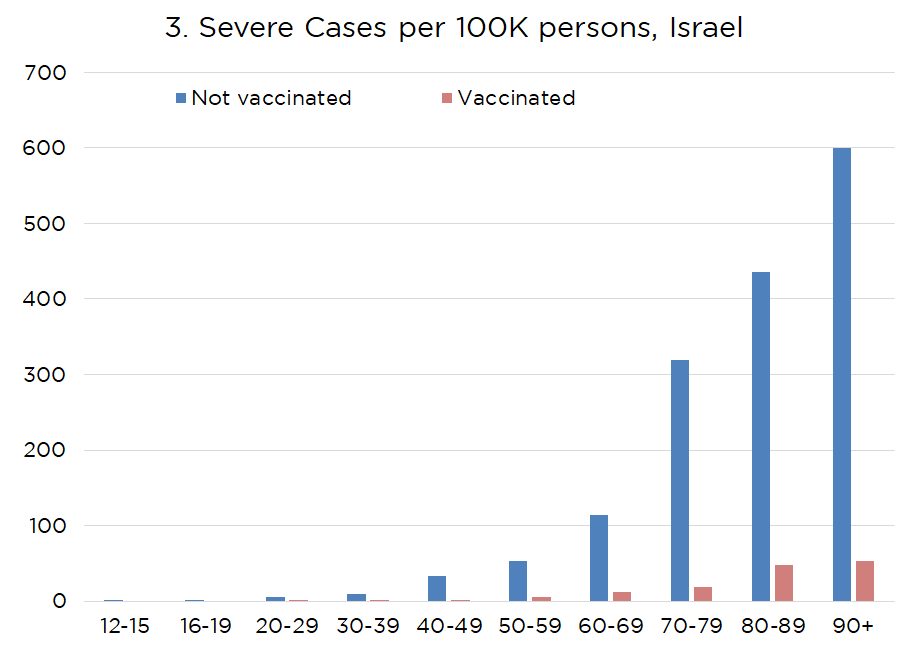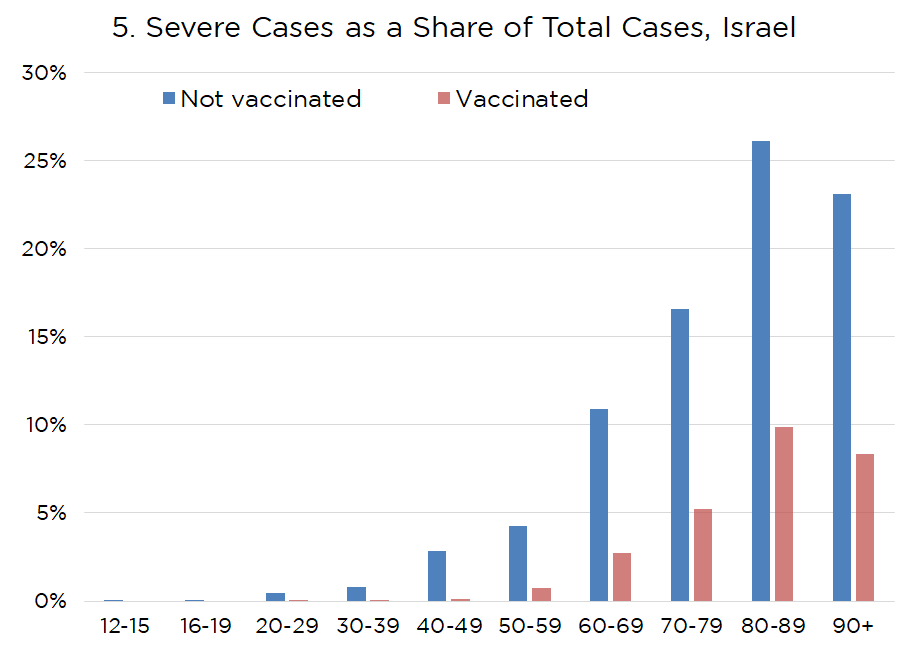Israeli Data Demonstrates the Importance, and the Limits, of Vaccination
September 17, 2021
Originally published at dtcochrane.com
DT Cochrane
I recently saw a misleading presentation of COVID data pertaining to Israel. In this post I’m sharing several graphs that I made to counter this misleading image.
Israel is currently a popular object of those committed to an anti-vax narrative because a high proportion of the population is fully vaccinated and cases there are currently spiking. The situation is obviously concerning. However, it is being misrepresented to feed anti-vax sentiments, which are dangerous. Epidemiological study shows that widespread vaccination is key to taming the vaccine, although not in isolation.
I went to the same Israeli government data source as the original misleading table. You can find the data for these charts here. It is in Hebrew. Thank the gods for Google Translate.
The first graph presents the data in a way similar to the table. It compares the share of the cases that are vaccinated with the share of the population that is vaccinated for different age groups.

The table being circulated by anti-vaxxers presents this data in ways designed to tell a misleading narrative. First, the table left out the data for the 12-15 and 16-19 age groups, which is already telling. Second, the choice of a table makes the values seem closer together than they are. Third, and most egregious, the table creator cherry-picked data from different datasets to make the values appear closer together than they are. All the data needed for the comparison can be found in a single, downloadable Excel workbook. However, the comparison made using that data is not as alarming as the misleading data.
As seen in the first graph, the values are closer together than one would like. However, this is still a misleading way to look at the data. As the vaccinated share of the population increase, the share of cases among the vaccinated will necessarily increase. The next graph is a more common way to present the data. In fact, this data is offered in this form.

This shows the number of cases among 100,000 people within each category of unvaccinated, vaccinated, and partially vaccinated. As you can see, unvaccinated people are much more likely to become infected.
Among 12-15 year olds, unvaccinated people are 9 times more likely to be infected. The gap between unvaccinated and vaccinated people closes for the 15 to 59 age groups. It is at its lost among 20 to 29 year olds, but still unvaccinated people are contracting the virus 30% more often than fully vaccinated people.
It might seem surprising that the case rate for fully vaccinated people is higher than the rate of partially vaccinated people. However, both the closing of the gap, and the lower case rate for the partially vaccinated likely demonstrate behaviour change among the vaccinated. Vaccinated people likely began to ignore other public health measures. This is why vaccination alone, even in highly vaccinated populations, will be insufficient. Also, the sub-80% vaccination rates among more highly social 20- and 30-somethings is also insufficient. These charts show that being vaccinated does reduce the likelihood of contracting the virus, though not as effectively as we would like. However, the next chart shows were vaccines are especially important: reducing the severity of a COVID infection.

The third chart is the number of severe infections per 100,000 people within the categories of vaccinated and unvaccinated. Severe infections are much, much higher among the unvaccinated. Because the rate of severe cases among our elders is so high, it makes it hard to see the difference for younger cohorts.
The next chart is limited to 20 to 59 year olds.

Among 40-49 year olds, an unvaccinated person is 30 times more likely to have a severe case.
Another way to look at this is to consider the share of cases deemed severe. I do this in the fifth chart. The numbers show us that unvaccinated people are more likely to get infected. Further, once infected, they are more likely to have a severe case. Among those 70 and over, an unvaccinated person who catched COVID has a one-in-five chance of it being a severe case. For the vaccinated, it is less than one-in-14.

Not getting COVID obviously benefits the person who avoids the virus. However, it also benefits everyone they come into contact with. Because unvaccinated people are more likely to contract the virus, it also increases their likelihood of spreading it. This does not even account for the fact that some early research indicates that even vaccinated people that have contracted the virus are less likely to transmit it. Healthy people who can become vaccinated, but choose not to, pose a danger to those who cannot be vaccinated, such as everyone under 12. Although COVID-19 has generally been less severe for children, the delta variant has sent more young kids to hospitals.
Because unvaccinated people have a higher likelihood of a severe case they also impose a greater cost, and present a greater risk to the health care system, which endangers us all. If they require hospitalization that diverts resources. The diversion of resources is not just within health care systems. In Orlando, COVID patients require so much oxygen, it is diverting supply from the city’s water treatment plants. City officials have asked residents to reduce their water usage because supplies are running low. At high enough levels of hospitalization, severe cases can completely overwhelm hospitals. Not only does this threaten the well-being of anyone else needed hospital care, it imposes a massive physical and emotional toll on health care workers.
Conclusion
I understand being skeptical of corporate controlled science. My PhD was essentially about the deleterious effects of corporate power. Corporations have introduced all sorts of manufactured chemicals into our lives with little regard for their long-term harms. However, most of those chemicals have never undergone anything close to the scrutiny of these vaccines.
Lots of the research done to produce these vaccines did not take place within corporations whose sole purpose is improving the bottom line. University research has been key. While there is excessive corporate influence on university research, much research remains outside the drive of commercialization.
Further, epidemiologists working outside the corporate ambit are pleading with the public to get vaccinated as a key to controlling the spread of COVID-19. Epidemiology is a fascinating field that deals with complex systems. It is a well-established field with a proven track record of prediction. Epidemiological models have demonstrated again and again that high levels of vaccination will staunch the spread.
There is uncertainty about the vaccine. And there are risks. We should not deny that. However, the risks and uncertainties associated with the virus are much, much higher. For both ourselves and for our neighbours, everyone that can get vaccinated should do so, as soon as possible.
Just as importantly, we need to demand the patents on the vaccines be waived. We need global manufacture and distribution of these life-saving medicines to ramp up quickly. While our first concern should be the people of poorer countries that cannot afford the vaccines, there are also selfish reasons to want high global vaccination. The longer there are large unvaccinated populations the more epigenetic drift we will get. Epigenetic drift increases the likelihood of more dangerous variants.
If nothing else, this pandemic should have taught us that the notion of the isolated, self-sufficient individual is a myth. Our lives are all interconnected. We to be accountable to each other, and take care of each other. A care and accountability approach to the vaccine requires us to get vaccinated, if we are physically able, and to make the vaccine available to everyone as quickly as possible.
